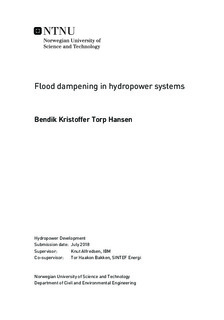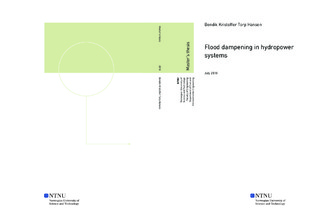| dc.description.abstract | The influence of the hydropower system on floods in the river Orkla was investigated by simulating flood events in regulated and unregulated conditions. A discharge time series was simulated using an HBV model with temperature and precipitation data inputs from the gridded dataset called seNorge2. The model was semi-distributed and simulated 7 separate catchments at the same time. A WEAP model was set up for the Orkla catchment draining to Bjørset, including all relevant rivers, reservoirs and transfers. Selected events from the HBV discharge timeseries were then simulated with and without regulation reservoirs in the system. The floods were simulated with three different initial water levels: empty, realistic, and full, where full is identical to no reservoir at all in this model. The effect of drawdown from full reservoirs prior to a flood event was investigated by defining the reservoirs as full and giving the system a set number of days to release water before the flood event. This was done for several different release capacities.
The results showed that the reservoirs were more than large enough to fully absorb all their flood inflows under the assumed realistic reservoir filling, and that the constraint on how much the flood was reduced by was controlled by the fraction of water flowing into the regulated areas versus the unregulated areas. The discharge capacities of the transfer intakes were shown to be a limiting factor in how much of the discharge was regulated, as the transfers suffered large spills at the highest floods. Different release capacities influenced the dampening potential significantly if the reservoir was full prior to a flood.
In addition to evaluating the flood dampening potential in Orkla, an attempt was done at finding a relationship between the regulation capacity and the flood dampening in reservoir systems in general. Due to a lack of real data to do an analysis on, a theoretical catchment with randomizable characteristics was created. The system had up to 10 reservoirs with random storage volumes and yearly inflows, and this enabled a variance in how much storage there was and where the storage was located compared to the inflows. Floods based on the Orkla flood hydrographs were simulated in the system, and the regulation capacity and flood dampening for hundreds of random configurations were generated. Curves were then fitted to the data.
The data from the hypothetical catchment showed that flood dampening varied greatly between catchments, even when they had the same regulation capacity. Furthermore, dampening could vary a lot between individual floods in one catchment, while in another the dampening could be the same for all the different floods. The curves were tested on data obtained from the literature study and performed relatively well considering the large spread in the synthesized data.
The development of a factor called flood regulation capacity was proposed to reduce the inaccuracies in the curves. This would remove storage that is not relevant for flood dampening purposes from the regulation capacity, such as filled or excessively large storage. | |

